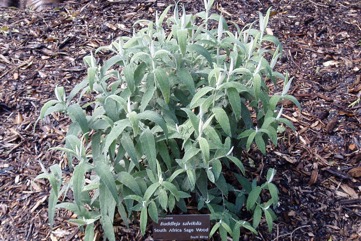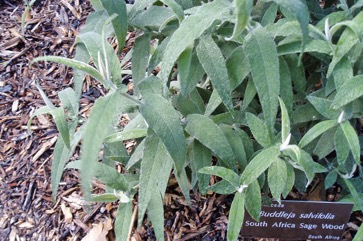South African sagewood

It is a warm temperate to subtropical plant. They grow at the edges of or in evergreen forest. They also occur on rocky mountain slopes and along watercourses. It needs a light to medium well-drained soil. It needs an open sunny position. It is resistant to drought and frost. In Zimbabwe it grows between 1,200-2,500 m above sea level. It suits hardiness zones 9-10. Geelong Botanical Gardens.
Also known as:
Chipambati, Ewanci, Ilotana, Lelothwane, Mupambati, Olothana, Sagewood, Umbatae-wepe, Winter Buddleia
Synonyms
- Buddleia salvifolia
Edible Portion
- Leaves, Leaves - tea
Where does South African sagewood grow?
Found in: Africa, Angola, Australia, Botswana, Central Africa, East Africa, Eswatini, Malawi, Mozambique, South Africa, Southern Africa, Swaziland, Tanzania, Tasmania, Zambia, Zimbabwe
Notes: There are about 90-100 Buddleja species. They are in the tropics and subtropics. Also put in the family Buddlejaceae.
Growing South African sagewood
Cultivation: Plants can be grown from seeds. Plants strike easily from cuttings. Hardwood cuttings treated with rooting hormone is best. They strike after 2-3 weeks. Adult trees can also be transplanted.
Edible Uses: CAUTION: The berries may be poisonous. The flowers and fresh or dried leaves are steeped in water, sweetened with honey and drunk in small doses as a health drink.
Production: They are fast growing.
Nutrition Info
per 100g edible portion| Edible Part | Energy (kcal) | Protein (g) | Iron (mg) | Vitamin A (ug) | Vitamin c (mg) | Zinc (mg) | % Water |
|---|---|---|---|---|---|---|---|
| Leaves - tea | - | - | - | - | - | - | |
| Flowers - tea | - | - | - | - | - | - |
South African sagewood Photos


References
Bodkin, F., 1991, Encyclopedia Botanica. Cornstalk publishing, p 175
Fox, F. W. & Young, M. E. N., 1982, Food from the Veld. Delta Books. p 257
Encycl. 1:513. 1785
Etherington, K., & Imwold, D., (Eds), 2001, Botanica's Trees & Shrubs. The illustrated A-Z of over 8500 trees and shrubs. Random House, Australia. p 147
Facciola, S., 1998, Cornucopia 2: a Source Book of Edible Plants. Kampong Publications, p 62
Fowler, D. G., 2007, Zambian Plants: Their Vernacular Names and Uses. Kew. p 78
Joffe, P., 2007, Creative Gardening with Indigenous Plants. A South African Guide. Briza. p 214
Long, C., 2005, Swaziland's Flora - siSwati names and Uses http://www.sntc.org.sz/flora/
Lord, E.E., & Willis, J.H., 1999, Shrubs and Trees for Australian gardens. Lothian. p 208
Palgrave, K.C., 1996, Trees of Southern Africa. Struik Publishers. p 778
Plowes, N. J. & Taylor, F. W., 1997, The Processing of Indigenous Fruits and other Wildfoods of Southern Africa. in Smartt, L. & Haq. (Eds) Domestication, Production and Utilization of New Crops. ICUC p 187
Ruiters-Welcome, A. K., 2019, Food plants of southern Africa. Ph.D. thesis. Univ. of Johannesburg p 102
Ryan, S., 2008, Dicksonia. Rare Plants Manual. Hyland House. p 11
Schmidt, E., Lotter, M., & McCleland, W., 2007, Trees and shrubs of Mpumalanga and Kruger National Park. Jacana Media p 544
Shava, S., 2000, The Use of Indigenous Plants as Food by a Rural Community in the Eastern Cape: an Educational Exploration. Masters Thesis Rhodes University. p 63
Swaziland's Flora Database http://www.sntc.org.sz/flora
Tredgold, M.H., 1986, Food Plants of Zimbabwe. Mambo Press. p 91
van Wyk, B, van Wyk, P, and van Wyk B., 2000, Photographic guide to Trees of Southern Africa. Briza. p 74
Venter, F & J., 2009, Making the most of Indigenous Trees. Briza. p 82
von Breitenbach, F., 1985, Southern Cape Tree Guide. Department of Environment Affairs, Forestry Branch. Pamphlet 360 Pretoria p 27
White, F., Dowsett-Lemaire, F. and Chapman, J. D., 2001, Evergreen Forest Flora of Malawi. Kew. p 338
Wilson, S., 1997, Some Plants are Poisonous. Reed. p 36
www.zimbabweflora.co.zw 2011